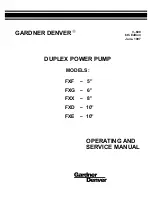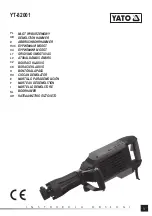
Page 17
For technical questions, please call 1-800-444-3353.
Item 61687
SAFET
y
Op
ERA
TION
M
AINTENAN
c
E
SETU
p
6.
IMpORTANT:
Center the belt on both pulleys so
that all the ridges on the Belt are aligned with all
the grooves on both Pulleys. See
Figure N
.
Figure N
7. Replace the Belt Cover. See
Figure O
.
Figure O
Troubleshooting
problem
possible causes
Likely Solutions
Tool will not start.
1. Cord not connected.
2. No power at outlet.
3. Tool’s thermal reset breaker
tripped (if equipped).
4. Internal damage or wear. (Carbon
brushes or Trigger, for example.)
1. Check that cord is plugged in.
2. Check power at outlet. If outlet is unpowered,
turn off tool and check circuit breaker.
If breaker is tripped, make sure circuit is right
capacity for tool and circuit has no other loads.
3. Turn off tool and allow to cool. Press reset button on tool.
4. Have technician service tool.
Tool operates slowly.
1. Forcing tool to work too fast.
2. Extension cord too long or cord
diameter too small.
1. Allow tool to work at its own rate.
2. Eliminate use of extension cord. If an extension
cord is needed, use one with the proper diameter
for its length and load. See
Extension Cords
in
Grounding
section on page 6.
Motor runs, but
tool does not plane
(Knife Drum does
not revolve).
Belt is damaged or broken.
Replace Belt. See
Replacing the Belt
on page 16.
Performance
decreases over time.
1. Carbon brushes worn or damaged.
2. Blade dull or damaged.
1. Have qualified technician replace brushes.
2. Keep blades sharp. Replace as needed.
Excessive noise
or rattling.
1. Internal damage or wear. (Carbon
brushes or bearings, for example.)
2. Belt is worn, stretched or broken.
1. Have technician service tool.
2. Replace Belt. (See
Replacing the Belt
on page 16.)
Overheating.
1. Forcing tool to work too fast.
2. Blade dull or damaged.
3. Blocked motor housing vents.
4. Motor being strained by long or
small diameter extension cord.
1. Allow tool to work at its own rate.
2. Keep blades sharp. Replace as needed.
3. Wear ANSI-approved safety goggles and
NIOSH-approved dust mask/respirator while
blowing dust out of motor using compressed air.
4. Eliminate use of extension cord. If an extension
cord is needed, use one with the proper diameter
for its length and load. See
Extension Cords
in
Grounding
section on page 6.
Follow all safety precautions whenever diagnosing or servicing the tool.
Disconnect power supply before service.
Содержание 61687
Страница 1: ......




































